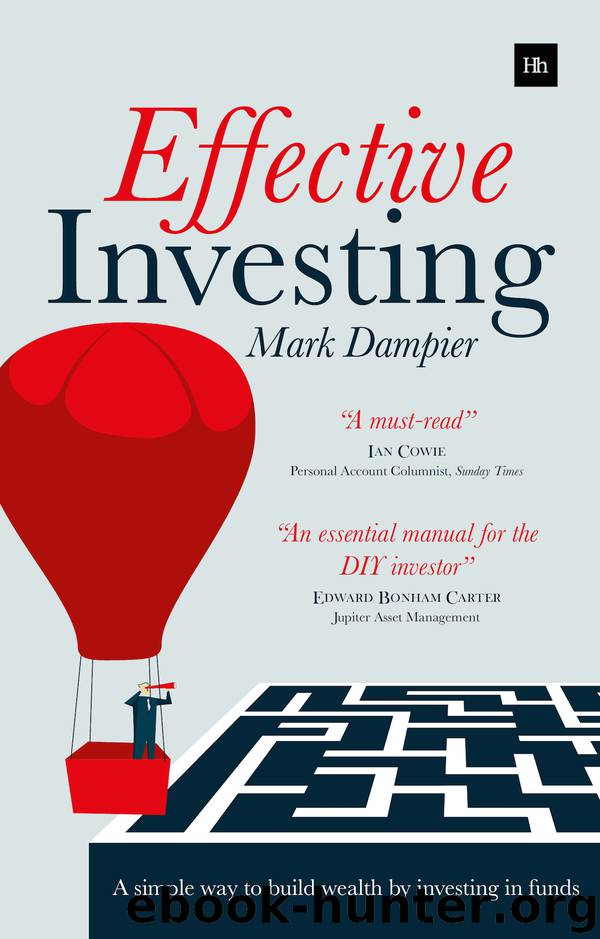Effective Investing by Mark Dampier

Author:Mark Dampier
Language: eng
Format: epub
Publisher: Harriman House
Published: 2015-10-16T09:06:37+00:00
Diversified and model portfolios
Everyone needs to have an element of diversification in their portfolio, to spread the risks and prepare for a range of uncertain outcomes. How you go about achieving this depends on where you are in the investment and savings spectrum. You may be just making a start on your investments and either building a portfolio gradually or looking to make a one-off initial investment which you may not be in a position to add to for a couple more years. Sometimes you may find yourself with a lump sum to invest: more common is to settle for a regular monthly or quarterly investment plan.
If you are making a one-off investment, you really want to be looking for a broad-based fund that covers all the main geographic markets. If you are starting off your investment portfolio and hope to add to it over the years, I believe that you should probably start off with a mainstream UK based fund as a core holding. You can always add a global equity fund, and the appropriate fixed-income funds for balance, at a later stage. With a more mature investment portfolio, it is easier to achieve better diversification from the beginning, even if it means reorganising what you already have. It makes sense as time goes by to look to blend one or more funds within each broad asset class that have complementary rather than identical strategies.
It is no coincidence, incidentally, that very few asset management companies have been able to add value consistently for their clients by making frequent asset-allocation decisions from one period to the next – in other words, changing the mix between shares, bonds, property and so forth on a regular basis. I see little evidence that most investment groups add value this way, and I certainly would not encourage you to do so. There are always some exceptions to this rule, but in my experience not many. For example, most professional investors were selling their bonds in 2010/11, yet bonds continued to be a great place to be right up to 2015.
As a general rule I believe that your bias should be towards making as few big calls as possible. Most big asset-allocation moves by investors tend to be knee-jerk emotive reactions to headline-grabbing events that are either happening elsewhere in the world, such as Greece or China, or are political rather than financial in nature, such as general elections. Most of the time these ‘critical’ events turn out to be more benign than they seem at the time. If anything, widespread fear of this kind of event can provide good entry points for topping up your holdings. They reflect emotions, not fundamentals. Sharp stock market falls are normally best seen as opportunities to buy, not to sell.
It is true that from time to time asset classes do become very expensive or very cheap when measured against their long-term history. It is here that knowing and understanding a bit of its history can help in terms of the valuation of a major asset class.
Download
This site does not store any files on its server. We only index and link to content provided by other sites. Please contact the content providers to delete copyright contents if any and email us, we'll remove relevant links or contents immediately.
Rich Dad Poor Dad by Robert T. Kiyosaki(6196)
Pioneering Portfolio Management by David F. Swensen(6092)
How To Win Friends and Influence People by Dale Carnegie(4342)
The Money Culture by Michael Lewis(3860)
The Dhandho Investor by Mohnish Pabrai(3574)
The Wisdom of Finance by Mihir Desai(3539)
Liar's Poker by Michael Lewis(3232)
The Intelligent Investor by Benjamin Graham Jason Zweig(2940)
The ONE Thing by Gary Keller(2925)
Mastering Bitcoin: Programming the Open Blockchain by Andreas M. Antonopoulos(2902)
Fooled by Randomness: The Hidden Role of Chance in Life and in the Markets by Nassim Nicholas Taleb(2872)
Rich Dad Poor Dad: What The Rich Teach Their Kids About Money - That The Poor And Middle Class Do Not! by Robert T. Kiyosaki(2842)
Investing For Dummies by Eric Tyson(2804)
How to Win Friends and Influence People by Dale Carnegie(2801)
How to Day Trade for a Living: Tools, Tactics, Money Management, Discipline and Trading Psychology by Andrew Aziz(2792)
Market Wizards by Jack D. Schwager(2549)
Zero Hour by Harry S. Dent Jr. & Andrew Pancholi(2541)
How to Pay Zero Taxes, 2018 by Jeff A. Schnepper(2508)
Rich Dad's Guide to Investing by Robert T. Kiyosaki(2418)
